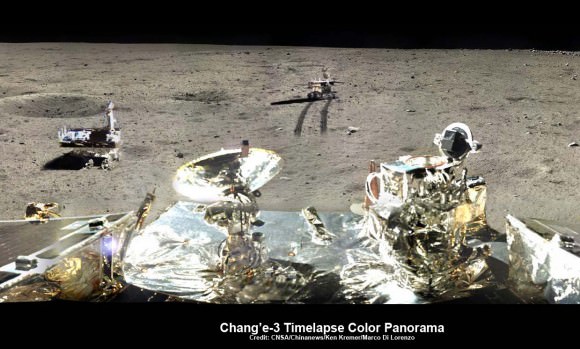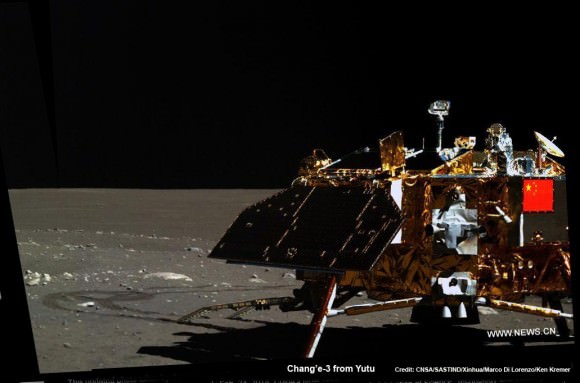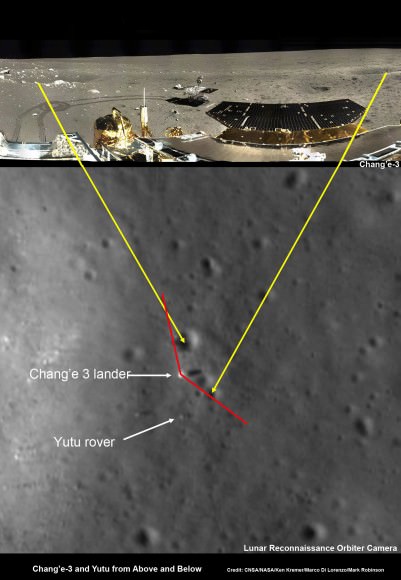This time-lapse color panorama from China’s Chang’e-3 lander shows the Yutu rover at two different positions during its trek over the Moon’s surface at its landing site from Dec. 15-18, 2013. This view was taken from the 360-degree panorama.
Credit: CNSA/Chinanews/Ken Kremer/Marco Di Lorenzo.
See our complete 5 position Yutu timelapse pano herein and 3 position pano at NASA APOD Feb. 3, 2014: http://apod.nasa.gov/apod/ap140203.htm
Story updated[/caption]
The serious technical malfunction afflicting the life and continued operations of China’s Yutu moon rover since the start of its second Lunar Night time hibernation in late January 2014 has been identified as an inability to properly maneuver the life giving solar panels, according to a top Chinese space official.
“Yutu suffered a control circuit malfunction in its driving unit,” according to a newly published report on March 1 by the state owned Xinhua news agency.
“The control circuit problem prevented Yutu from entering the second dormancy as planned,” said Ye Peijian, chief scientist of the Chang’e-3 program, in an exclusive interview with Xinhua.
At the time that Yutu’s 2nd Lunar sleep period began on Jan. 25, 2014, Chinese space officials had announced that the robot’s future was in jeopardy after it suffered an unidentified “ mechanical control anomaly” due to the “complicated lunar surface.”
A functioning control circuit is required to lower the rovers mast and protect the delicate components and instruments mounted on the mast from directly suffering from the extremely harsh cold of the Moon’s recurring night time periods.
“Normal dormancy needs Yutu to fold its mast and solar panels,” said Ye.
The high gain communications antenna and the imaging cameras are attached to the mast.
They must be folded down into a warmed electronics box to shield them from the damaging effects of the Moon’s nightfall when temperatures plunge dramatically to below minus 180 Celsius, or minus 292 degrees Fahrenheit.

This newly expanded timelapse composite view shows China’s Yutu moon rover at two positions passing by crater and heading south and away from the Chang’e-3 lunar landing site forever about a week after the Dec. 14, 2013 touchdown at Mare Imbrium. This cropped view was taken from the 360-degree timelapse panorama. See complete 360 degree landing site timelapse panorama herein and APOD Feb. 3, 2014. Chang’e-3 landers extreme ultraviolet (EUV) camera is at right, antenna at left. Credit: CNSA/Chinanews/Ken Kremer/Marco Di Lorenzo – kenkremer.com. See our complete Yutu timelapse pano at NASA APOD Feb. 3, 2014: http://apod.nasa.gov/apod/ap140203.htm
The solar panels also generate power during each Lunar day to keep the robot alive and conduct its mission of scientific exploration roving across the lunar terrain.
The rover and Chang’e-3 stationary lander must power down and sleep during each lunar night since there is no sunlight available to generate power and no communications are possible with Earth.
The panel driving unit also helps maneuver the panels into position to efficiently point to the sun to maximize the electrical output.
“The driving unit malfunction prevented Yutu to do those actions” said Ye.
Each lunar day and night lasts for alternating periods of 14 Earth days.
“This means Yutu had to go through the lunar night in extremely low temperatures.”
Apparently the mast was not retracted and remained vertical during the lunar nights 2 and 3.
And the camera somehow survived the harsh temperature decline and managed to continue operating since it snapped two images of the Chan’ge-3 lander during Lunar Day 3. See our two image mosaic – below.

In addition to being chief scientist of the Chang’e-3 program Ye is also a member of the National Committee of the Chinese People’s Political Consultative Conference, the country’s top political advisory body.
Yutu is China’s first ever Moon rover and successfully accomplished a soft landing on the Moon on Dec. 14, 2013, piggybacked atop the Chang’e-3 mothership lander.
Barely seven hours after touchdown, the six wheeled moon buggy drove down a pair of ramps onto the desolate gray plains of the lunar surface at Mare Imbrium (Sea of Rains) covered by volcanic material.
For a time in mid-February, mission scientists feared that Yutu would no longer function when because no signals were received until two days later than the planned “awakening” from Lunar Night 2 on Feb. 10.

Fortunately, Yutu did finally wake up some 48 hours late on Feb. 12 and function on Lunar Day 3.
And the team engaged in troubleshooting to try and identify and rectify the technical problems.
Since then, Chinese space engineers engaged in troubleshooting to try and identify and rectify the technical problems in a race against time to find a solution before the start of Lunar Night 3.
The 140 kilogram rover was unable to move during Lunar Day 3 due to the mechanical glitches.
“Yutu only carried out fixed point observations during its third lunar day.” according to China’s State Administration of Science, Technology and Industry for National Defence (SASTIND), responsible for the mission.
However it did complete some limited scientific observations. And fortunately the ground penetrating radar, panoramic and infrared imaging equipment all functioned normally.
Yutu and the companion Chang’e-3 lander have again gone into sleep mode during Lunar Night 3 on Feb. 22 and Feb 23 respectively, local Beijing time.
But the issue with the control circuit malfunction in its driving unit remains unresolved and still threatens the outlook for Yutu’s future exploration.
See our new Chang’e-3/Yutu lunar panoramas by Ken Kremer and Marco Di Lorenzo herein and at NASA APOD on Feb. 3, 2014.

Yutu is now nearing its planned 3 month long life expectancy on a moon roving expedition to investigate the moon’s surface composition and natural resources.
The 1200 kg stationary lander is functioning normally. It is as expected to return science data about the Moon and conduct telescopic observations of the Earth and celestial objects for at least one year.
Yutu, which translates as ‘Jade Rabbit’ is named after the rabbit in Chinese mythology that lives on the Moon as a pet of the Moon goddess Chang’e.
“We all wish it would be able to wake up again,” said Ye according to CCTV, China’s state run broadcaster.
Ye will be reporting about Yutu and the Chang’e-3 mission at the annual session of the top advisory body, which opened today, Monday, March 3.
China is only the 3rd country in the world to successfully soft land a spacecraft on Earth’s nearest neighbor after the United States and the Soviet Union.
Stay tuned here for Ken’s continuing Chang’e-3, Orion, Orbital Sciences, SpaceX, commercial space, Curiosity, GPM, LADEE, Mars and more planetary and human spaceflight news. Learn more at Ken’s upcoming presentations at the NEAF convention on April 12/13.



As I said before, it was a good try of Chinese scientists…
Even though Yutu lasted short, we are excited again, after long delay for Moon landings… I hope Chinese continues Moon missions…
That’s good news. Now that the mission controllers know what the problem is, they’re more likely to find ways of coping with it.